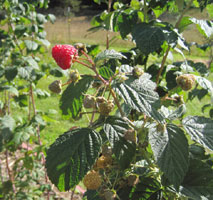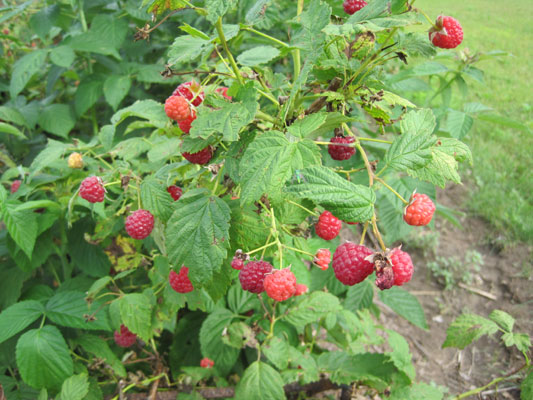2022
-
Good harvest, Aug. 18 last small picking, lots of SWD damage. Quite a
bit stem borer issues, cut off tips when droop, burn. Letting Boyne
and Killarney fill in between plums in central area. Smaller than
in main (well mulched) bed but still fruiting. Both have good flavor.
Killarney quite a good harvest. Transplanted one into main bed west,
will let expand into Prelude spot. Killarney has better flavor.
Prelude had decent crop in spite of poorish plants, used mainly for
vinegar. Removed plants after harvest; planted buckwheat/oats.
Latham - good in spit of some disease. Started last week July,
good crop, good flavor.
MacBlack - Very lush, vigorous, some disease but lots of berries.
Pruned out some canes. Next year only leave 2 or 3. Shortened vigorous, thorney,
canes. Great crop, first half August. Getting SWD later. Really like the flavor.
2021 - Mild winter, little snow, hot summer, dry
spring - it wasn't the friendliest plant weather but some things liked it, and
some didn't. The raspberries were mixed. Prelude was ripe early July and
did fine. Latham had many dead canes, others sparse and slow to leaf. It
may be a disease issue. I'll give them another year. I missed the fruit.
Mac-Black raspberries didn't do well. The older canes and laterals all
winter killed, though the new growth looked good. I missed that fruit, too! I
know it's on the edge here zone-wise but I'm still holding out hope. Will see
how they do next year. The Pequot Black Raspberry leafed out before
everything else, all tips winterkilled. Put out some small partial fruit,
foliage rough. Cut down and dug out later.
In May I "planted" Wood Bluet Mushroom
spore in the mixed mulch bed I made last fall along the north side of the
raspberries. I found a few fruits so am hoping for a harvest next year (see
Mushroom page).
2019
-
Another hard winter, even for the usually
hardy raspberries. Prelude lost many canes but there were enough left for a
decent crop. They are the earliest to ripen, starting July 17 this year, lasting
a couple of weeks. They aren't as sweet as Latham but they are appreciated as
they are.
Since SWD (see below) are still around in good number the harvest was sporadic,
especially toward the end. I did as I have the last years, pick every ripe (or
close to ripe) berry every day, eat the good ones, toss the mushy ones (into a
bucket of water for a few days). I appreciate the Hummingbirds (and anything
else that might be making a meal of the SWD), plant more flowers they might
like, and try not to get too upset about it. They're here, and we're here, and
we're all eating raspberries, though our share is less right now. I expect it
will balance out.
The Latham also had some winterkilled canes
but did well overall. They start as Preludes are ending but the SWD did a pretty
good job on them this year so harvest was sparse. They are worth the trouble to
get what I can though being a very tasty raspberry.
I finally accepted that Nova just doesn't
like it here, or the canes I bought came with their own issues. I think it might
be the latter given the high regards others have for this variety. But I dug
them all out and planted a few of the volunteer seedlings that were growing all
over the garden (thanks to tossing buckets of SWD infested berries onto the
compost pile the last few years). The mint also found a new home here. The old plot had gotten
quite full of unwanted perennials so it was time to start afresh. The end of the
raspberry plot seemed a good option, especially since there was that empty spot
where the Nova had been. No spot in the garden stays empty for long.
There are also new Boyne and Killarney
growing in the nearby orchard. They are looking good and I hope to have berries
in a few years from them. I have grown both before, and like them. Being in the
less "civilized" orchard environment instead of the cushy garden plot they will
probably be a bit slower to grow but they are both sturdy, hardy varieties.
The big surprise, a very pleasant one, was
the black raspberry I had planted last year. Here is my report on the day I ate
the first one, August 4...
 Something
new arrived in the homestead berry world today - our very first black
raspberry (aka blackcaps), a hardy variety called MacBlack. Just a few
ripe fruit so far but are they every good! I hadn't had a black
raspberry since a child when we had wild ones growing along the edge of
our yard. I don't really remember them much, just that I'd eat them now
and then when out playing, as I did the red raspberries that grew mostly
untended beside a shed. Black raspberries don't grow wild around here
and are mostly for warmer zones, but I'd read of a few hardier varieties
so decided to give them a try, hoping I'd like them if they survived. Something
new arrived in the homestead berry world today - our very first black
raspberry (aka blackcaps), a hardy variety called MacBlack. Just a few
ripe fruit so far but are they every good! I hadn't had a black
raspberry since a child when we had wild ones growing along the edge of
our yard. I don't really remember them much, just that I'd eat them now
and then when out playing, as I did the red raspberries that grew mostly
untended beside a shed. Black raspberries don't grow wild around here
and are mostly for warmer zones, but I'd read of a few hardier varieties
so decided to give them a try, hoping I'd like them if they survived.
Well I certainly do like them! They have a somewhat similar taste to red
raspberries but not the same. They taste, well, like black raspberries.
 They
are firmer than the reds and the canes have much more serious thorns,
more like a rose. Definitely something to respect. My first plant made
it through its first winter so I planted two more this spring, another MacBlack and a Pequot Lakes. That was all I had room for. I do hope they
decide they like it here and can handle the winters. These first
ones are ripening a bit later than the reds (the Preludes have finished
and the Lathams are about midway in their season) and should still be
ripening when the Lathams are done. Since I mostly like the raspberries
for fresh snacking it will be nice to have the season extended,
hopefully into the fall. Thankfully the SWD left them pretty much alone.
Now that I've tasted those first few
berries I'll be better able to be patient and let them truly ripen to a
rich, sweet black before picking them. We're truly rich in berries here
on the homestead. They
are firmer than the reds and the canes have much more serious thorns,
more like a rose. Definitely something to respect. My first plant made
it through its first winter so I planted two more this spring, another MacBlack and a Pequot Lakes. That was all I had room for. I do hope they
decide they like it here and can handle the winters. These first
ones are ripening a bit later than the reds (the Preludes have finished
and the Lathams are about midway in their season) and should still be
ripening when the Lathams are done. Since I mostly like the raspberries
for fresh snacking it will be nice to have the season extended,
hopefully into the fall. Thankfully the SWD left them pretty much alone.
Now that I've tasted those first few
berries I'll be better able to be patient and let them truly ripen to a
rich, sweet black before picking them. We're truly rich in berries here
on the homestead.
Raspberries -
2016-2018
Having written and published the Berries book in 2016
with a good long chapter on raspberries I haven’t had much to add here on the
website. I continue to mulch, the plants continue to grow and produce, each year
brings its own diversity, and we eat raspberries. Except for 2017...
SWD - Spotted Wing Drosophila - an East Asian vinegar or
fruit fly that has made quite an infamous name for itself this decade in the
U.S. fruit world. She particularly likes the soft fruits and unlike the fruit
flies we’re most familiar with she likes her fruit fresh, not for eating but as a
nursery for her eggs. Laying her eggs inside the nicely ripe berries they soon
become larva and quite unpalatable to us, and unsaleable for farmers. There is
quite a lot of panic in the horticultural world about this.
I noticed the fly, or rather the results of the larva in
the fruit, in 2016 in the wild blackberries. We have quite a few on our property
which are mostly just grazed as one walks by, but sometimes I pick enough for a
batch of wine. But that year every berry I picked was mushy. It is quite obvious
when a berry is infested. I figured it was some disease. Our wild blackberries
aren’t always real healthy; it varies year to year. Disappointing, but since I
couldn’t do anything about it I simply passed on the blackberries that year. I
didn’t notice anything similar in my tame berries.
Then 2017 season arrived and there was no doubt the SWD
had found my raspberries. And to a lesser extent the blueberries (not nearly as
bad, thankfully). By then I’d learned a bit about this little creature. Reading
up on recommendations, looking to find something that would fit my way of
gardening (no chemicals), I finally decided on a mild strategy that I often use
on other crops with disease or insect problems - pick it.
I put a bucket of water by the berries. All summer,
every day or two, I picked EVERY raspberry. The small number that felt firm and
good were eaten or went to make raspberry vinegar. If it felt at all mushy it
went into the bucket of water. Most of them were the latter. It wasn’t the most
fun harvest I’ve done but I felt it would work. I let the bucket sit for several
days then emptied it into the compost pile - again and again and again, until
the harvest was over. This was one year I truly welcomed any and all birds to
help themselves to all the raspberries they could eat. I was particularly
overjoyed when one day late summer I had what I assume was a fledged family or
two of hummingbirds. I’d never seen anything like it (I usually only see two
adults) - maybe eight or ten (they were really hard to count!) mostly young
hummingbirds having a thoroughly fun and crazy time flying around and through
the garden, chasing each other and who knows what else, buzzing me, and
hopefully eating their fill of fruit flies.
 All
considered I did end up with a small harvest. Mid September the Preludes started
blossoming again and setting fruit for a fall crop. They weren’t giving up! The
bees loved the gift of late blossoms. Prelude and Latham will both often set
some fall fruit but it hardly ever matures here, and the few that start coloring
up are quickly snatched by the birds, especially the bluejays. This fall had
been cool to cold with frosts starting the first of September, lots of rain and
many freezes. So I didn't expect ripe fruit. But one day in early October I was
walking by the raspberries and there, almost in my face, was this beautiful,
large, healthy, firm ripe raspberry! With many more coming on. And few bluejays
around. What a treat. I set the disappointments of the season behind me and
thoroughly enjoyed this beautiful gem. All
considered I did end up with a small harvest. Mid September the Preludes started
blossoming again and setting fruit for a fall crop. They weren’t giving up! The
bees loved the gift of late blossoms. Prelude and Latham will both often set
some fall fruit but it hardly ever matures here, and the few that start coloring
up are quickly snatched by the birds, especially the bluejays. This fall had
been cool to cold with frosts starting the first of September, lots of rain and
many freezes. So I didn't expect ripe fruit. But one day in early October I was
walking by the raspberries and there, almost in my face, was this beautiful,
large, healthy, firm ripe raspberry! With many more coming on. And few bluejays
around. What a treat. I set the disappointments of the season behind me and
thoroughly enjoyed this beautiful gem.
 2018
- The winter had been a tough one for the raspberries (and many other
perennials, shrubs and trees). There was quite a bit of winterkill in the patch,
more than usual, but it turned into an unusually long, nice, warm/hot growing
season. Plants thrived; we had a reasonably good harvest with very little sign
of SWD presence. I noticed the hummingbirds hanging around the raspberries -
good sign! The wild blackberries also were reasonably good, and little to no
mushy blueberries. So, was it the hummingbirds? A SWD crash? My picking every
raspberry? An unknown SWD preditor? Or the usual ups and downs of nature,
bringing things back into balance. Could be any, all, or none. One way or
another I was happy and content to let the mystery be. 2018
- The winter had been a tough one for the raspberries (and many other
perennials, shrubs and trees). There was quite a bit of winterkill in the patch,
more than usual, but it turned into an unusually long, nice, warm/hot growing
season. Plants thrived; we had a reasonably good harvest with very little sign
of SWD presence. I noticed the hummingbirds hanging around the raspberries -
good sign! The wild blackberries also were reasonably good, and little to no
mushy blueberries. So, was it the hummingbirds? A SWD crash? My picking every
raspberry? An unknown SWD preditor? Or the usual ups and downs of nature,
bringing things back into balance. Could be any, all, or none. One way or
another I was happy and content to let the mystery be.
A side result of the 2017 "berries in the bucket into
the compost" strategy was a generous number of "volunteer seedlings" I found in
my potting soil (made from compost) and in the garden. I noticed them first in
the greenhouse in the seedling flats. I seldom see seedling raspberries so was
interested, transplanting a few to a pot to grow out and see what the fruit
would be like. But soon I realized there were more than just a few and ended up
weeding them out as they popped up. Likewise in the garden, though I have let a
few grow. It will be interesting to see how they do (healthy so far) and what
the fruit will be like. I have three tame varieties and plenty of wild
raspberries around for interesting cross pollination.
For more discussion and info
on raspberries check out my
"Growing Berries for Food and
Fun" book which includes strawberries, raspberries, blueberries and grapes,
published in 2016.
Copyright © Susan Robishaw |







